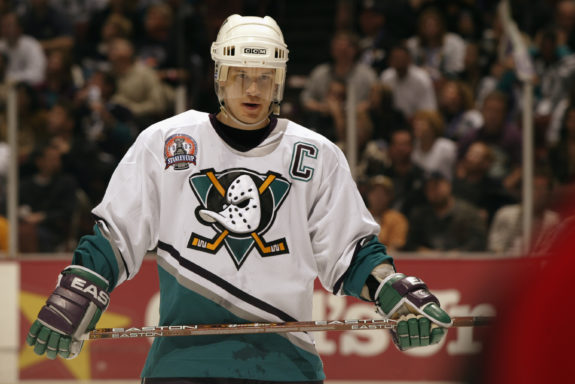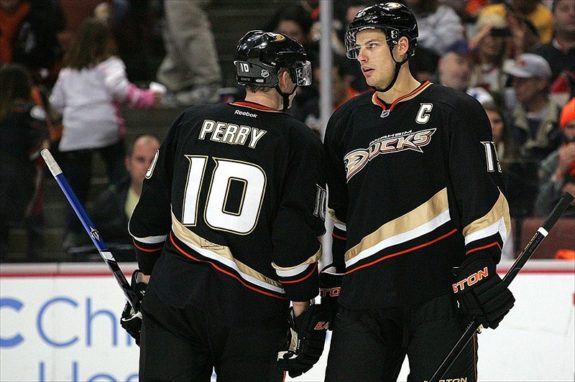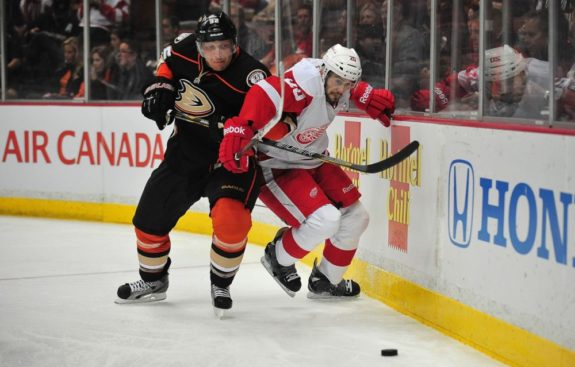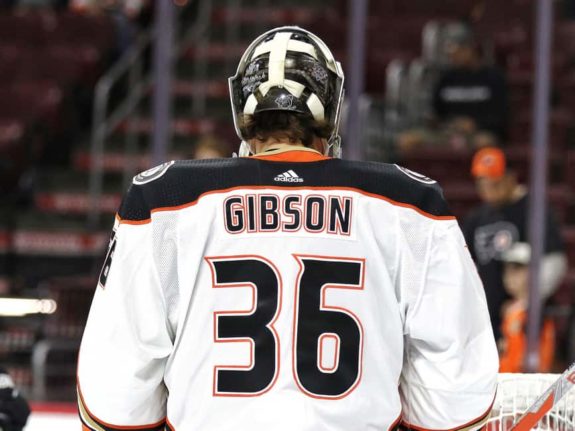
 Anthony Ciardelli
The Hockey Writers
Anthony Ciardelli
The Hockey Writers
46
Reads
0
Comments
Remembering the Anaheim Mighty Ducks’ 2003 Draft
RThe Anaheim Ducks just wrapped up their 25th season in franchise history. With the draft lottery behind them and the NHL Draft ahead, the Ducks and their fans are hoping that the next batch of draftees will develop into future pieces of a Stanley Cup winning team. In the Ducks’ 25-year history, there has been no more impactful draft than in 2003, the year they drafted Ryan Getzlaf and Corey Perry in the first round. In the spirit of looking forward to the future by looking to the past, let’s dig into the details of the Ducks’ 2003 NHL Draft.
Runner-Up Mighty Ducks Looking to Reach the Top
For the Mighty Ducks (as they were known at the time) the 2002-03 NHL season already ranked as the best in their history. With 40 wins, they accumulated the most victories in franchise history and qualified for the playoffs for only the third time since they came into the league in 1993. Once the playoffs began, the Mighty Ducks rolled. First, they swept the defending Stanley Cup champion and second-seeded Detroit Red Wings.
In the second round, Anaheim took down the Western Conference first-seeded Dallas Stars four games to two. After sweeping the Minnesota Wild in the conference finals, Anaheim took the New Jersey Devils and Martin Brodeur — at the height of his powers — all the way to Game 7 of the Stanley Cup Final before falling 3-0 in the deciding game.

With their first ever Stanley Cup appearance under their belt, the Mighty Ducks entered the 2003 Draft in search of more goal-scoring punch after finishing that regular season ranked No. 23 in goals scored. In addition, Paul Kariya was a free agent, and although he didn’t sign with the Colorado Avalanche until after the draft, Anaheim needed to prepare for the chance their franchise forward would leave.
Diving into the Deepest Draft
The 2003 NHL Draft is considered one of the most talented drafts of all-time. Of the 30 players selected in the first round, more than half (17) made an NHL All-Star team at some point in their career. The first-rounders alone have collected 18 Stanley Cups, nine Olympic Gold Medals, a Norris Trophy, a Selke Trophy, a Hart Trophy and a Rocket Richard Trophy.
The first round also included career NHL players Braydon Coburn, Steve Bernier, Eric Fehr, Mark Stuart and Patrick Eaves. The second round had fewer big names, but the players it did include were just as decorated on an individual basis. Patrice Bergeron, Corey Crawford, Shea Weber and Jimmy Howard all went in round two as did David Backes, and Loui Eriksson. Even the later rounds featured some big names. Joe Pavelski went in round seven, Tobias Enstrom and Dustin Byfuglien went in round eight, and Jaroslav Halak and Brian Elliott went in round nine.
Mighty Ducks’ Big Picks
The Mighty Ducks runner-up finish in 2002-03 did not push their own first-round pick to the second-to-last spot like it would’ve with the current rules. Instead, position in the final regular season standings determined the draft order outside of the lottery. Thus, with the seventh-best record in their conference, the Mighty Ducks pick occurred at No. 19 rather than No. 29.
In addition to the No. 19 pick, the Mighty Ducks also possessed the No. 28 pick which they procured from the Stars by trading them two second-round picks in that same draft. Interestingly, one of those picks originated from their trade of Teemu Selanne to the San Jose Sharks on March 5, 2001.
Armed with two first-round picks, Mighty Ducks general manager Bryan Murray went to work. At No. 19 he selected Getzlaf, who had played his major-junior hockey with the Western Hockey League’s Calgary Hitmen. Nine picks later, Murray chose Perry at No. 28 from the Ontario Hockey League’s London Knights.
Perry & Getzlaf Leave a Legacy
What Perry and Getzlaf have accomplished with Anaheim is legendary to say the least. Together, they helped win the Ducks their first Stanley Cup in franchise history in 2006-07. Perry won the Hart and Rocket Richard Trophies in 2011, a season in which he had 50 goals and 48 assists.

They are first and second in games played for the Ducks (Perry has played 988, Getzlaf 984) and are likely to be the first Ducks players to play 1,000 games for the team. Perry ranks second in goals scored for the Ducks at 372, while Getzlaf ranks fourth at 261.
They sit second and third in points scored in team history with 923 for Getzlaf and 776 for Perry.
Even in such a deep draft, it’s safe to say that Anaheim nailed it. With the benefit of hindsight, it’s hard to question their decisions or feel disappointed about missing out on another player, even one like Bergeron, Burns or Weber.
For Murray (who passed away in 2017), the man who drafted both players, the success must’ve been bittersweet. After the Mighty Ducks disappointed in 2003-04, Murray resigned and later became head coach of the Ottawa Senators. He stood behind the bench and watched Perry and Getzlaf, along with their Ducks teammates, celebrate their Stanley Cup victory over his Senators in 2007.
Late Rounds, Long Careers
The Mighty Ducks’ draft success came in more than just the first round. Of all the players Anaheim picked in 2003, four played in NHL games. Though there have been 11 other drafts where Anaheim selected four or more players to play an NHL game, 2003 stands out for the longevity and effectiveness of the players they selected.
In addition to Getzlaf and Perry, Murray picked forward Drew Miller in the sixth round and defenseman Shane O’Brien in the eighth. Miller complied 571 NHL games during his career, scoring 62 goals and adding 60 assists in that time. He last played in the NHL in 2016-17.

O’Brien had similar success playing 537 NHL games in his career, scoring 13 goals and adding 79 assists from the blue line. At 3,080 NHL games combined, 2003 is by far the most successful draft in terms of NHL service from the players the Ducks drafted.
The next closest draft year, 1996, featured only two players to play in the NHL. They were 1,516-game NHL veteran Matt Cullen, who as of now, is still playing, and 917-game NHL veteran Ruslan Salei, totaling 2,433 games combined.
While Miller and O’Brien only played 54 and 62 games, respectively, for Anaheim, their careers in the NHL, especially for later round picks, goes to show just how well Murray could identify NHL players.
Battle of the Ducks’ Best Drafts
Compared with other Ducks drafts, there are a couple of others that come close to 2003 in terms of meaning for the franchise. Their first draft, in 1993, obviously holds a lot of meaning because the Mighty Ducks drafted Kariya No. 4 overall. Kariya ended up having the most productive career of anyone in that draft, and it fell at a crucial time for the franchise. As I mentioned in a previous article, Kariya’s draft came in the first year of the Mighty Ducks franchise, and his first year playing, in 1994, followed a lockout.
His status as an all-time college player created buzz and maintained fan interest during the 1994-95 lockout. However, he didn’t play a role in a Stanley Cup with the Ducks as Getzlaf and Perry did. The rest of the 1993 Draft also did not produce much in terms of NHL success. Goaltender Mikhail Shtalenkov, who had the next most fruitful NHL career after Kariya, does not have his number hanging in the rafters of any NHL arena and neither does anyone else from that year.
Of the Ducks most recent drafts, 2011 does have the potential to surpass 2003. All seven of Anaheim’s picks from that year have played in the NHL. That includes current core players John Gibson, Rickard Rakell and Josh Manson and fringe defenseman Andy Welinski.

Time will tell if 2011 overtakes 2003. For now, considering all of the success that Perry and Getzlaf have had with the Ducks, as well as the careers of O’Brien and Miller, 2003 ranks as the most important draft in Ducks franchise history.
The post Remembering the Anaheim Mighty Ducks’ 2003 Draft appeared first on The Hockey Writers.
Popular Articles

















































 Blackhawks Chicago
Blackhawks Chicago Panthers Florida
Panthers Florida Penguins Pittsburgh
Penguins Pittsburgh Rangers New York
Rangers New York Avalanche Colorado
Avalanche Colorado Kings Los Angeles
Kings Los Angeles Maple Leafs Toronto
Maple Leafs Toronto Bruins Boston
Bruins Boston Capitals Washington
Capitals Washington Flames Calgary
Flames Calgary Oilers Edmonton
Oilers Edmonton Golden Knights Vegas
Golden Knights Vegas Islanders New York
Islanders New York Sabres Buffalo
Sabres Buffalo Red Wings Detroit
Red Wings Detroit Flyers Philadelphia
Flyers Philadelphia Senators Ottawa
Senators Ottawa Lightning Tampa Bay
Lightning Tampa Bay Devils New Jersey
Devils New Jersey Hurricanes Carolina
Hurricanes Carolina Blue Jackets Columbus
Blue Jackets Columbus Predators Nashville
Predators Nashville Wild Minnesota
Wild Minnesota Blues St. Louis
Blues St. Louis Stars Dallas
Stars Dallas Jets Winnipeg
Jets Winnipeg Mammoth Utah
Mammoth Utah Sharks San Jose
Sharks San Jose Canucks Vancouver
Canucks Vancouver Ducks Anaheim
Ducks Anaheim






